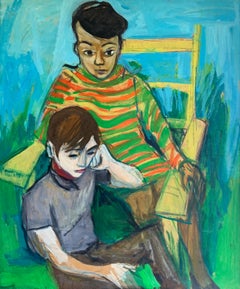Paul Keene
1960s Expressionist Still-life Paintings
Oil, Board
1960s Expressionist Still-life Paintings
Oil, Board
1970s Expressionist Portrait Paintings
Oil, Board
1970s Expressionist Portrait Paintings
Oil, Board
1950s Expressionist Still-life Paintings
Oil, Canvas
1960s Expressionist Portrait Paintings
Oil, Board
1960s Expressionist Portrait Paintings
Oil, Board
1960s Expressionist Portrait Paintings
Oil, Board
1950s Expressionist Portrait Paintings
Board, Oil
1950s Expressionist Portrait Paintings
Oil, Cardboard
1970s Expressionist Portrait Paintings
Oil, Board
1970s Expressionist Portrait Paintings
Oil, Board
1970s Expressionist Portrait Paintings
Board, Oil
1960s Expressionist Portrait Paintings
Oil, Board
1950s Expressionist Landscape Paintings
Oil, Canvas
1950s Expressionist Portrait Paintings
Cardboard, Oil
1950s Expressionist Portrait Paintings
Oil, Canvas
1970s Expressionist Portrait Paintings
Oil, Board
1970s Expressionist Still-life Paintings
Board, Oil
1960s Expressionist Portrait Paintings
Oil, Board
1970s Expressionist Portrait Paintings
Oil, Board
1970s Expressionist Portrait Paintings
Oil, Board
1960s Expressionist Portrait Paintings
Oil, Board
1970s Expressionist Portrait Paintings
Oil, Board
1960s Expressionist Portrait Paintings
Board, Oil
1960s Expressionist Portrait Paintings
Canvas, Oil
1960s Expressionist Portrait Paintings
Oil, Board
1970s Expressionist Portrait Paintings
Canvas, Oil
1960s Expressionist Portrait Paintings
Board, Oil
1960s Expressionist Portrait Paintings
Oil, Board
Recent Sales
1970s Expressionist Still-life Paintings
Oil, Board
1970s Expressionist Portrait Paintings
Oil, Board
1960s Expressionist Still-life Paintings
Oil, Board
1960s Expressionist Portrait Paintings
Oil, Board
Mid-20th Century Cubist Abstract Paintings
Masonite, Casein
Mid-20th Century Abstract Abstract Drawings and Watercolors
Paper, Ink
1960s Expressionist Portrait Paintings
Oil, Board
1960s Abstract Abstract Paintings
People Also Browsed
1970s Modern Figurative Paintings
Gouache
Paul Keene For Sale on 1stDibs
How Much is a Paul Keene?
Bernard Harmon for sale on 1stDibs
Bernard Harmon was born in Philadelphia, Pennsylvania, in 1935. He was primarily a portrait painter and a well-loved teacher in the Philadelphia area. A graduate of the Philadelphia Museum School and Temple University’s Tyler School of Art, Harmon traveled extensively in Europe and South America.
Beloved by many, Harmon taught in the Philadelphia School District for 32 of his 54 years of life. Beginning his career as an art teacher at West Philadelphia High School in the early 1960s, he became one of the district's artists-in-residence, traveling from school to school to demonstrate for students how an artist works. Returning to the classroom, Harmon joined the art department at Central High School where he taught for 14 years and became an innovator in its art curriculum, developing a program offering advanced placement art classes to gifted students. In his final years Harmon became a supervisor, mentoring teachers and overseeing programs in the Philadelphia school system’s District #1.
During his short life Harmon taught college preparatory art classes at the Pennsylvania Academy of the Fine Arts, summer classes at the University of the Arts, and a Saturday program for gifted children at Drexel University.
Among Harmon's portraits were commissioned by Philadelphia Jazz organist Jimmy Smith and Mayor Richardson Dilworth. The artist was active in promoting African American artists throughout his lifetime. He organized many early shows such as the "Afro American Artists 1800–1969" at the Museum of the Philadelphia Civic Center in 1969, and was considered a Renaissance man by friends and colleagues for his interests not only in art but music and theater as well. Harmon was familiar and friends with many other African American artists such as Doc Thrash, Selma Burke, Paul Keene Jr., Allen Freelon and Charles Searles.
Harmon's work reflects his love of his students and friends. His art has a loose expressionist style that can be related to the work of Alice Neel. A 2016 exhibition at Gratz Gallery & Conservation Studio was one of the largest offerings of Bernard Harmon’s work in many years.
Find original Bernard Harmon paintings and other art on 1stDibs.
(Biography provided by Gratz Gallery & Conservation Studio)
A Close Look at Expressionist Art
While “expressionist” is used to describe any art that avoids naturalism and instead employs a bold use of flattened forms and intense brushwork, Expressionist art formally describes early-20th-century work from Europe that drew on Symbolism and confronted issues such as urbanization and capitalism. Expressionist artists experimented in paintings and prints with skewed perspectives, abstraction and unconventional, bright colors to portray how isolating and anxious the world felt rather than how it appeared.
Between 1905 and 1920, Austrian and German artists, in particular, were inspired by Postimpressionists such as Paul Gauguin and Vincent van Gogh in their efforts to strive for a new authenticity in their work. In its geometric patterns and decorative details, Expressionist art was also marked by eclectic sources like German and Russian folk art as well as tribal art from Africa and Oceania, which the movement’s practitioners witnessed at museums and world’s fairs.
Groups of artists came together to share and promote the themes now associated with Expressionism, such as Die Brücke (The Bridge) in Dresden, which included Erich Heckel, Ernst Ludwig Kirchner and Karl Schmidt-Rottluff and investigated alienation and the dissolution of society in vivid color. In Munich, Der Blaue Reiter (The Blue Rider), a group led by Wassily Kandinsky and Franz Marc, instilled Expressionism with a search for spiritual truths. In his iconic painting The Scream, prolific Norwegian painter Edvard Munch conveyed emotional turmoil through his depiction of environmental elements, such as the threatening sky.
Expressionism shifted around the outbreak of World War I, with artists using more elements of the grotesque in reaction to the escalation of unrest and violence. Printmaking was especially popular, as it allowed artists to widely disseminate works that grappled with social and political issues amid this time of upheaval. Although the art movement ended with the rise of Nazi Germany, where Expressionist creators were labeled “degenerate,” the radical ideas of these artists would influence Neo-Expressionism that emerged in the late 1970s with painters like Jean-Michel Basquiat and Francesco Clemente.
Find a collection of authentic Expressionist paintings, sculptures, prints and more art on 1stDibs.
Finding the Right Paintings for You
Painting is an art form that has spanned innumerable cultures, with artists using the medium to tell stories, explore and communicate ideas and express themselves. To bring abstract paintings, landscape paintings, still-life paintings and other original paintings into your home is to celebrate and share in the long tradition of this discipline.
When we look at paintings, particularly those that originated in the past, we learn about history, other cultures and countries of the world. Like every other work of art, paintings — whether they are contemporary creations or works that were made during the 19th century — can often help us clearly see and understand the world around us in a meaningful and interesting way.
Cave walls were the canvases for what were arguably the world’s first landscape paintings, which depict natural scenery through art. Portrait paintings and drawings, which, along with sculpture, were how someone’s appearance was recorded prior to the advent of photography, are at least as old as Ancient Egypt. In the Netherlands, landscapes were a major theme for painters as early as the 1500s. Later, artists in Greece, Rome and elsewhere created vast wall paintings to decorate stately homes, churches and tombs.
Today, creating a wall of art is a wonderful way to enhance your space, showcase beautiful pieces and tie an interior design together.
No matter your preference, whether you favor Post-Impressionist paintings, animal paintings, Surrealism, Pop art or another movement or specific period, arranging art on a blank wall allows you to evoke emotions in a room while also showing off your tastes and interests. A symmetrical wall arrangement may comprise a grid of four to six pieces or, for an odd number of works, a horizontal row. Asymmetrical arrangements, which may be small clusters of art or large, salon-style gallery walls, have a more collected and eclectic feel.
Download the 1stDibs app, which includes a handy “View on Wall” feature that allows you to see how a particular artwork will look on a particular wall, and read about how to arrange wall art. And if you’re searching for the perfect palette for your interior design project, what better place to turn than to the art world’s masters of color?
On 1stDibs, you’ll find an expansive collection of paintings and other fine art for your home or office. Browse abstract paintings, portrait paintings, paintings by emerging artists and more today.




